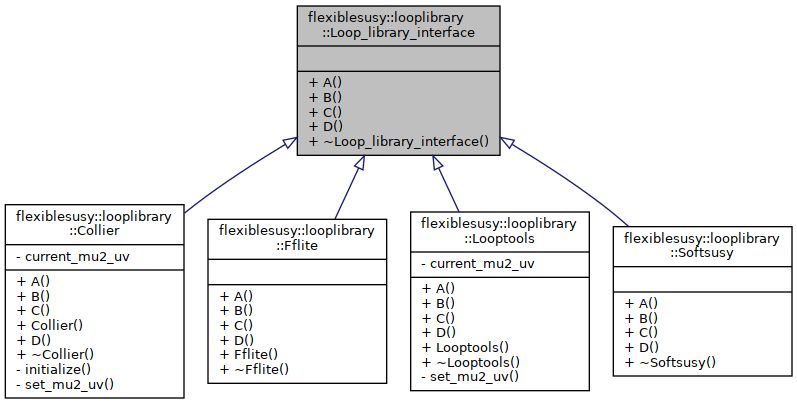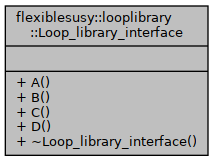flexiblesusy::looplibrary::Loop_library_interface Class Referenceabstract interface for different one loop function libraries with conventions of DE == [arXiv:0709.1075], arguments order as in LT == [http://www.feynarts.de/looptools/LT215Guide.pdf], filling of given arrays as in CO == [arXiv:1604.06792]. More...
Inheritance diagram for flexiblesusy::looplibrary::Loop_library_interface:

Collaboration diagram for flexiblesusy::looplibrary::Loop_library_interface:

Detailed Descriptioninterface for different one loop function libraries with conventions of DE == [arXiv:0709.1075], arguments order as in LT == [http://www.feynarts.de/looptools/LT215Guide.pdf], filling of given arrays as in CO == [arXiv:1604.06792]. Loop_library_interface is the abstract base class for one loop functions. It defines the following set of loop functions names: one-point ones: A, A0 two-point ones: B, B0, B1, B00, DB0, DB1, DB00 three-point ones: C, C0, C1, C2, C00, C11, C12, C22 four-point ones: D, D0, D1, D2, D3, D00, D11, D12, D13, D22, D23, D33. For making the notation a little bit shorter the following abbreviations for input momenta and masses are used: A_ARGS means a single std::complex<double> m02 - squared mass of particle in a loop (see sec. 1.3.1 of [LT]; name is different). B_ARGS means a set of std::complex<double> p10, m02, m12 - squared momenta and masses of particle in a loop (see sec. 1.3.2 of [LT]; names are different, order is the same). C_ARGS means a set of std::complex<double> p10, p21, p20, m02, m12, m22 - squared momenta and masses of particle in a loop (see sec. 1.3.4 of [LT]; names are different, order is the same). D_ARGS means a set of std::complex<double> p10, p21, p32, p30, p20, p31, m02, m12, m22, m32 - squared momenta and masses of particle in a loop (see sec. 1.3.5 of [LT]; names are different, order is the same). Functions with numeric indices return std::complex<double> of corresponding Passarino-Veltman coefficient (see r.h.s. of eq. (4.4) in [DE]). Ti and Tij functions accept T_ARGS, scl2 as arguments, where scl2 is squared scale (squared mu of eq. (4.1) in [DE]). Example 1: B0(B_ARGS, scl2) means B0(p10, m02, m12, scl2) with: p10, m02, m12 being of std::complex<double> type; scl2 being of double type; p10 is p^2 from section 1.3.2 of [LT], m02 is m1^2 from section 1.3.2 of [LT], m12 is m2^2 from section 1.3.2 of [LT] - order is as in [LT]; scl2 is squared scale (squared mu of eq. (4.1) in [DE]); returns T^1_0 from eq. (4.4) in [DE] of std::complex<double> type. A, B, DB, C, D functions return void, their first arguments are std::complex<double> arrays of fixed length (passed by a reference), which equals to 1, 3, 3, 7, 11. They fill given array with values of Passarino-Veltman coefficients (inspect table 3 of [CO]). After the first argument goes T_ARGS sequence, then scl2, which is described by the following example: Example 2: C(c, C_ARGS, scl2) means C(c, p10, p21, p20, m02, m12, m22, scl2) with: c being array of std::complex<double> of fixed length 7 filled by C function with C0, C1, C2, C00, C11, C12, C22 coefficients (order is defined by table 3 of [CO], coefficients are defined by r.h.s. of eq. (4.4) in [DE]); p10 is p1^2 from section 1.3.4 of [LT], p21 is p2^2 from section 1.3.4 of [LT], p20 is (p1+p2)^2 from section 1.3.4 of [LT], m02 is m1^2 from section 1.3.4 of [LT], m12 is m2^2 from section 1.3.4 of [LT], m22 is m3^2 from section 1.3.4 of [LT] - order is as in [LT]; scl2 is squared scale (squared mu of eq. (4.1) in [DE]); returns void. Definition at line 183 of file loop_library_interface.hpp. Constructor & Destructor Documentation◆ ~Loop_library_interface()
Definition at line 196 of file loop_library_interface.hpp. Member Function Documentation◆ A()◆ B()◆ C()◆ D()◆ DB()The documentation for this class was generated from the following file: Generated on Sun Apr 6 2025 11:10:38 for FlexibleSUSY by |
||||||||||||||||||||||||||||||||||